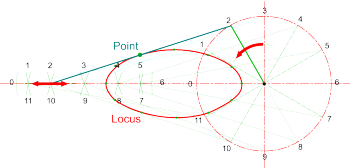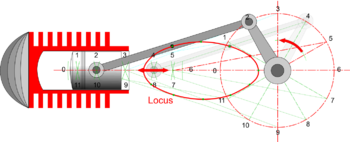Loci: Difference between revisions
From DT Online
mNo edit summary |
(Added main image) |
||
| (One intermediate revision by the same user not shown) | |||
| Line 1: | Line 1: | ||
[[File:Trammel of Archimedes with three sliders.gif|200px|right|Trammel of Archimedes with three sliders|link=https://en.wikipedia.org/wiki/Trammel_of_Archimedes]] | |||
__TOC__ | __TOC__ | ||
| Line 10: | Line 11: | ||
More practically it is sometimes necessary to know the path traced by the ends of pieces of machinery to check clearances, estimate the velocities at different parts of a linkage ''(perhaps to calculate | More practically it is sometimes necessary to know the path traced by the ends of pieces of machinery to check clearances, estimate the velocities at different parts of a linkage ''(perhaps to calculate [https://en.wikipedia.org/wiki/Momentum '''Momentum'''])'' or to design guarding for example. The general method is to draw the linkage or mechanism in several ‘freeze frame’ positions then draw a smooth curve through the plotted points. | ||
| Line 17: | Line 18: | ||
{| cellpadding="5" | {| cellpadding="5" | ||
|- | |- | ||
| '''Plotting Loci on a Crank and Slider Mechanism''' | | '''Plotting Loci on a [[Crank and Slider]] Mechanism''' | ||
| <span style="color:#B00000"> | | <span style="color:#B00000"> | ||
* Draw a schematic of the | * Draw a schematic of the '''[[Crank and Slider]]''' and divide the [https://en.wikipedia.org/wiki/Crank_(mechanism) '''Crank'''] rotation into a number of equal divisions ''(say, 12)'' | ||
* Number the | * Number the [https://en.wikipedia.org/wiki/Crank_(mechanism) '''Crank'''] positions and, with radius set to the length of the connecting rod, strike arcs from each position along the horizontal line which the [https://en.wikipedia.org/wiki/Piston '''Piston'''] is constrained to slide along. | ||
* If the requirement is for the | * If the requirement is for the '''Locus''' of the centre of the [https://en.wikipedia.org/wiki/Connecting_rod '''Connecting Rod'''], then mark these points on each position and join with a smooth curve as shown. | ||
* It may sometimes be necessary to draw in additional details of the mechanisms, to test clearances for example. | * It may sometimes be necessary to draw in additional details of the mechanisms, to test clearances for example. | ||
* Loci on parts of other mechanisms can be plotted using a similar process | * '''Loci''' on parts of other mechanisms can be plotted using a similar process ''(i.e. draw the mechanism in different positions and connect plotted points to create the '''Locus''')''. | ||
</span> | </span> | ||
| [[File:LociCrankSlider.png |350px|right]] | | [[File:LociCrankSlider.png |350px|right]] | ||
Latest revision as of 09:27, 14 March 2017
Description
The Locus of a Point is the path traced by a point as it moves in accordance with set conditions and constraints. The plural of Locus is Loci.
For example: the locus of all points a set distance from another point is a circle; the locus of all points equidistant from the ends of a line is the perpendicular bisector of the line; and the locus of all points a set distance from a given line are lines parallel to it (or an oval if the locus continues round the ends of the line)
More practically it is sometimes necessary to know the path traced by the ends of pieces of machinery to check clearances, estimate the velocities at different parts of a linkage (perhaps to calculate Momentum) or to design guarding for example. The general method is to draw the linkage or mechanism in several ‘freeze frame’ positions then draw a smooth curve through the plotted points.
Constructions
| Plotting Loci on a Crank and Slider Mechanism |
|
|












